JEEP CHEROKEE 2021 Owner handbook (in English)
Manufacturer: JEEP, Model Year: 2021, Model line: CHEROKEE, Model: JEEP CHEROKEE 2021Pages: 332, PDF Size: 8.87 MB
Page 251 of 332
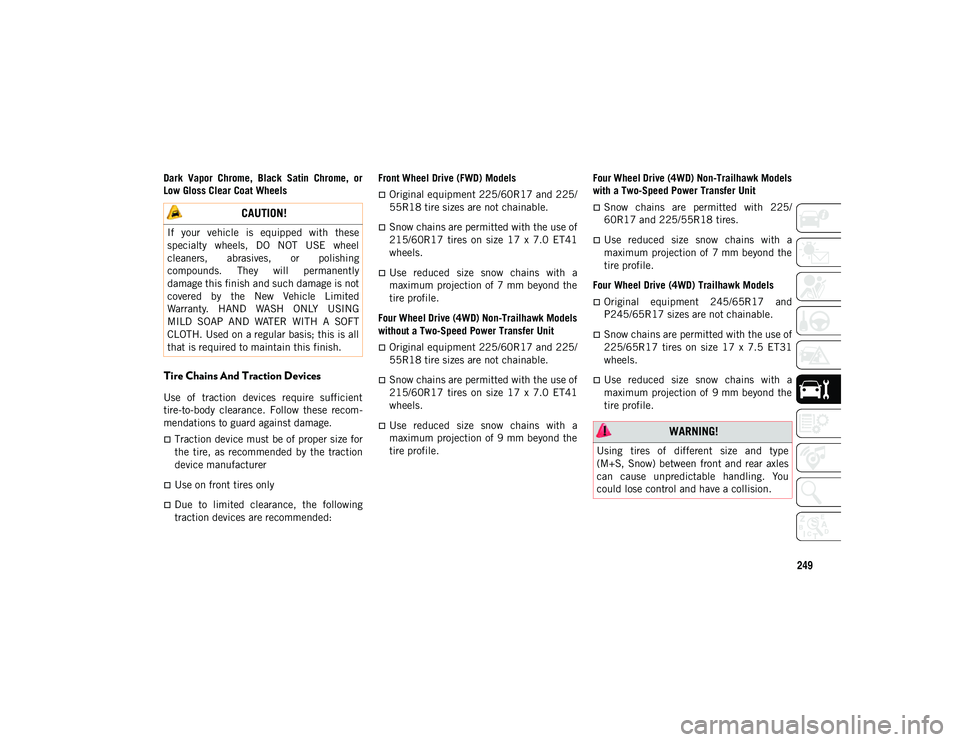
249
Dark Vapor Chrome, Black Satin Chrome, or
Low Gloss Clear Coat Wheels
Tire Chains And Traction Devices
Use of traction devices require sufficient
tire-to-body clearance. Follow these recom-
mendations to guard against damage.
Traction device must be of proper size for
the tire, as recommended by the traction
device manufacturer
Use on front tires only
Due to limited clearance, the following
traction devices are recommended: Front Wheel Drive (FWD) Models
Original equipment 225/60R17 and 225/
55R18 tire sizes are not chainable.
Snow chains are permitted with the use of
215/60R17 tires on size 17 x 7.0 ET41
wheels.
Use reduced size snow chains with a
maximum projection of 7 mm beyond the
tire profile.
Four Wheel Drive (4WD) Non-Trailhawk Models
without a Two-Speed Power Transfer Unit
Original equipment 225/60R17 and 225/
55R18 tire sizes are not chainable.
Snow chains are permitted with the use of
215/60R17 tires on size 17 x 7.0 ET41
wheels.
Use reduced size snow chains with a
maximum projection of 9 mm beyond the
tire profile. Four Wheel Drive (4WD) Non-Trailhawk Models
with a Two-Speed Power Transfer Unit
Snow chains are permitted with 225/
60R17 and 225/55R18 tires.
Use reduced size snow chains with a
maximum projection of 7 mm beyond the
tire profile.
Four Wheel Drive (4WD) Trailhawk Models
Original equipment 245/65R17 and
P245/65R17 sizes are not chainable.
Snow chains are permitted with the use of
225/65R17 tires on size 17 x 7.5 ET31
wheels.
Use reduced size snow chains with a
maximum projection of 9 mm beyond the
tire profile.
CAUTION!
If your vehicle is equipped with these
specialty wheels, DO NOT USE wheel
cleaners, abrasives, or polishing
compounds. They will permanently
damage this finish and such damage is not
covered by the New Vehicle Limited
Warranty. HAND WASH ONLY USING
MILD SOAP AND WATER WITH A SOFT
CLOTH. Used on a regular basis; this is all
that is required to maintain this finish.
WARNING!
Using tires of different size and type
(M+S, Snow) between front and rear axles
can cause unpredictable handling. You
could lose control and have a collision.
2020_JEEP_CHEROKEE_UG_RHD_UK.book Page 249
Page 252 of 332
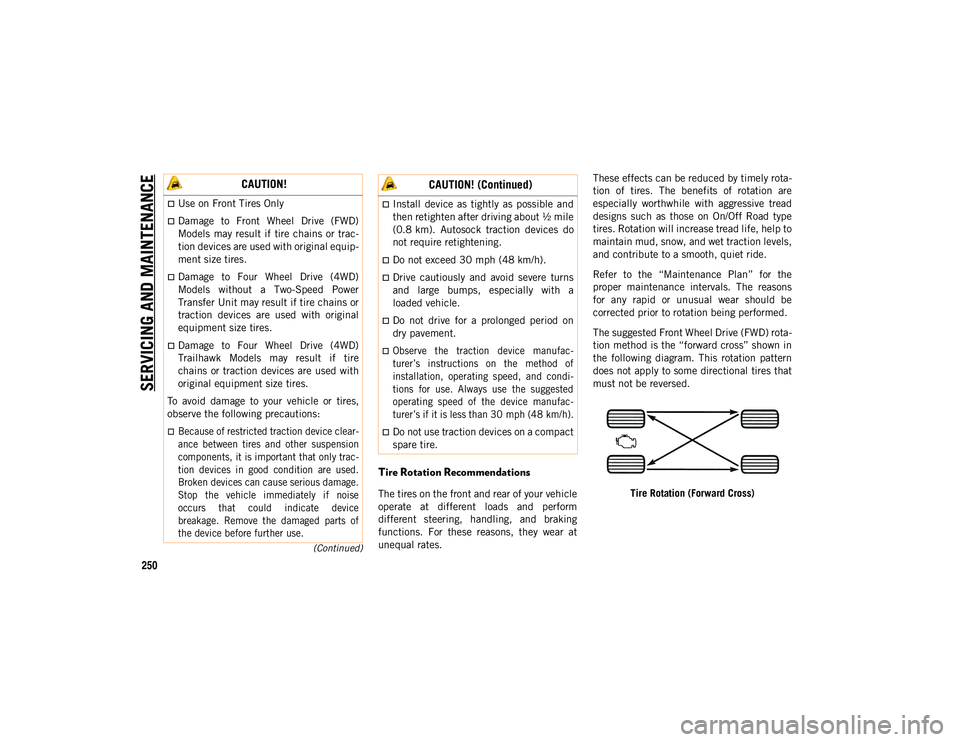
SERVICING AND MAINTENAN
CE
250
(Continued)
Tire Rotation Recommendations
The tires on the front and rear of your vehicle
operate at different loads and perform
different steering, handling, and braking
functions. For these reasons, they wear at
unequal rates.These effects can be reduced by timely rota
-
tion of tires. The benefits of rotation are
especially worthwhile with aggressive tread
designs such as those on On/Off Road type
tires. Rotation will increase tread life, help to
maintain mud, snow, and wet traction levels,
and contribute to a smooth, quiet ride.
Refer to the “Maintenance Plan” for the
proper maintenance intervals. The reasons
for any rapid or unusual wear should be
corrected prior to rotation being performed.
The suggested Front Wheel Drive (FWD) rota -
tion method is the “forward cross” shown in
the following diagram. This rotation pattern
does not apply to some directional tires that
must not be reversed.
Tire Rotation (Forward Cross)
CAUTION!
Use on Front Tires Only
Damage to Front Wheel Drive (FWD)
Models may result if tire chains or trac-
tion devices are used with original equip -
ment size tires.
Damage to Four Wheel Drive (4WD)
Models without a Two-Speed Power
Transfer Unit may result if tire chains or
traction devices are used with original
equipment size tires.
Damage to Four Wheel Drive (4WD)
Trailhawk Models may result if tire
chains or traction devices are used with
original equipment size tires.
To avoid damage to your vehicle or tires,
observe the following precautions:
Because of restricted traction device clear -
ance between tires and other suspension
components, it is important that only trac -
tion devices in good condition are used.
Broken devices can cause serious damage.
Stop the vehicle immediately if noise
occurs that could indicate device
breakage. Remove the damaged parts of
the device before further use.
Install device as tightly as possible and
then retighten after driving about ½ mile
(0.8 km). Autosock traction devices do
not require retightening.
Do not exceed 30 mph (48 km/h).
Drive cautiously and avoid severe turns
and large bumps, especially with a
loaded vehicle.
Do not drive for a prolonged period on
dry pavement.
Observe the traction device manufac -
turer’s instructions on the method of
installation, operating speed, and condi -
tions for use. Always use the suggested
operating speed of the device manufac -
turer’s if it is less than 30 mph (48 km/h).
Do not use traction devices on a compact
spare tire.
CAUTION! (Continued)
2020_JEEP_CHEROKEE_UG_RHD_UK.book Page 250
Page 253 of 332
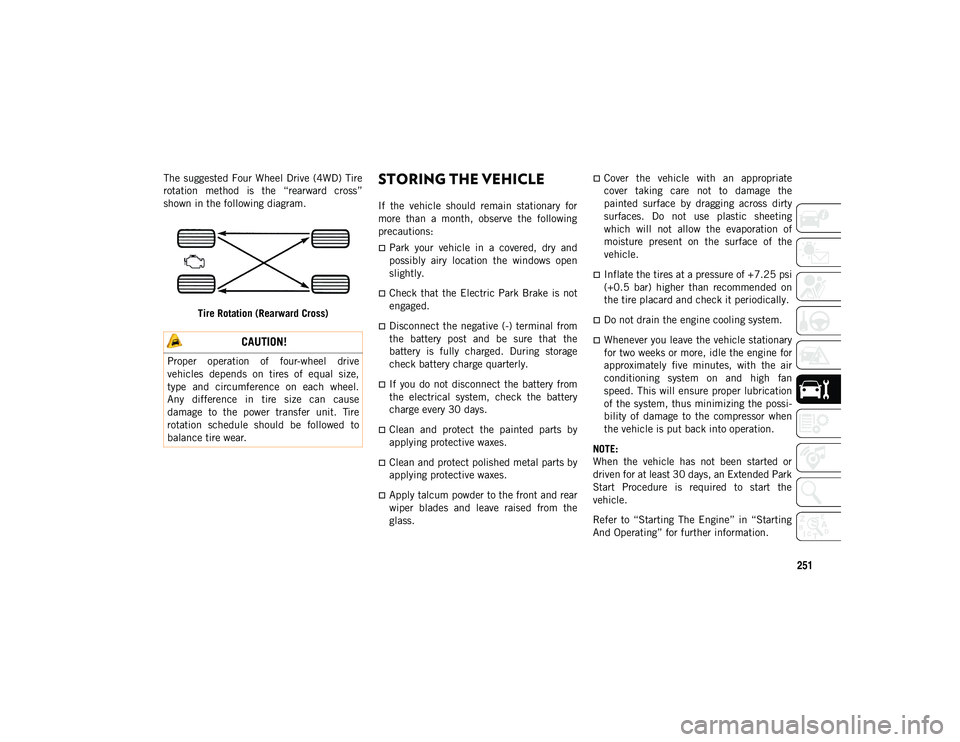
251
The suggested Four Wheel Drive (4WD) Tire
rotation method is the “rearward cross”
shown in the following diagram.Tire Rotation (Rearward Cross)STORING THE VEHICLE
If the vehicle should remain stationary for
more than a month, observe the following
precautions:
Park your vehicle in a covered, dry and
possibly airy location the windows open
slightly.
Check that the Electric Park Brake is not
engaged.
Disconnect the negative (-) terminal from
the battery post and be sure that the
battery is fully charged. During storage
check battery charge quarterly.
If you do not disconnect the battery from
the electrical system, check the battery
charge every 30 days.
Clean and protect the painted parts by
applying protective waxes.
Clean and protect polished metal parts by
applying protective waxes.
Apply talcum powder to the front and rear
wiper blades and leave raised from the
glass.
Cover the vehicle with an appropriate
cover taking care not to damage the
painted surface by dragging across dirty
surfaces. Do not use plastic sheeting
which will not allow the evaporation of
moisture present on the surface of the
vehicle.
Inflate the tires at a pressure of +7.25 psi
(+0.5 bar) higher than recommended on
the tire placard and check it periodically.
Do not drain the engine cooling system.
Whenever you leave the vehicle stationary
for two weeks or more, idle the engine for
approximately five minutes, with the air
conditioning system on and high fan
speed. This will ensure proper lubrication
of the system, thus minimizing the possi -
bility of damage to the compressor when
the vehicle is put back into operation.
NOTE:
When the vehicle has not been started or
driven for at least 30 days, an Extended Park
Start Procedure is required to start the
vehicle.
Refer to “Starting The Engine” in “Starting
And Operating” for further information. CAUTION!
Proper operation of four-wheel drive
vehicles depends on tires of equal size,
type and circumference on each wheel.
Any difference in tire size can cause
damage to the power transfer unit. Tire
rotation schedule should be followed to
balance tire wear.
2020_JEEP_CHEROKEE_UG_RHD_UK.book Page 251
Page 254 of 332
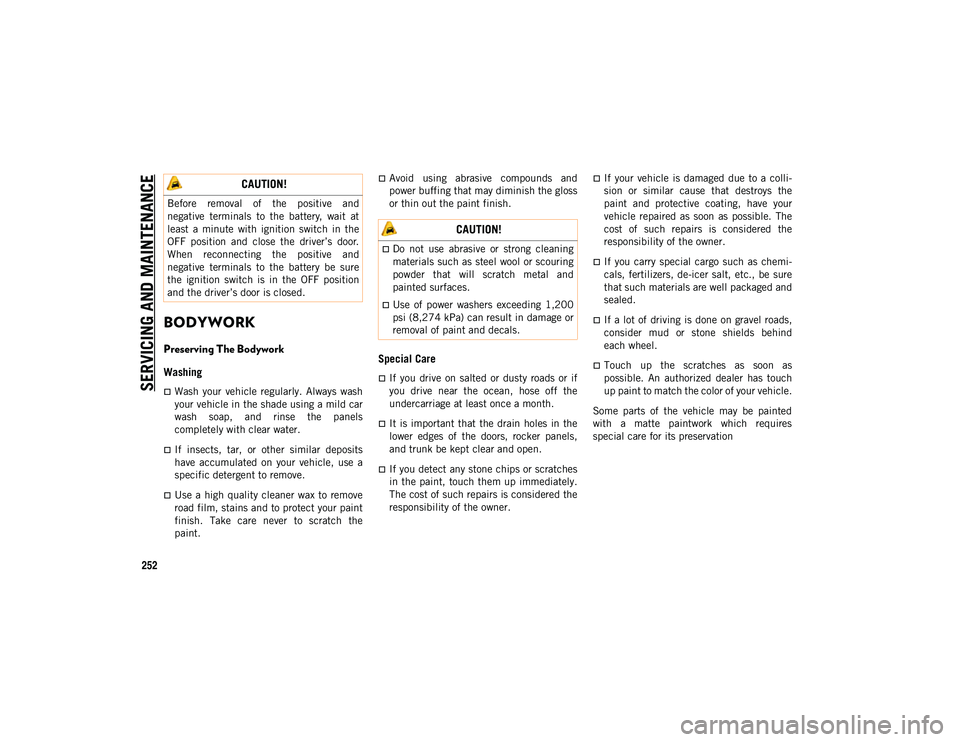
SERVICING AND MAINTENAN
CE
252
BODYWORK
Preserving The Bodywork
Washing
Wash your vehicle regularly. Always wash
your vehicle in the shade using a mild car
wash soap, and rinse the panels
completely with clear water.
If insects, tar, or other similar deposits
have accumulated on your vehicle, use a
specific detergent to remove.
Use a high quality cleaner wax to remove
road film, stains and to protect your paint
finish. Take care never to scratch the
paint.
Avoid using abrasive compounds and
power buffing that may diminish the gloss
or thin out the paint finish.
Special Care
If you drive on salted or dusty roads or if
you drive near the ocean, hose off the
undercarriage at least once a month.
It is important that the drain holes in the
lower edges of the doors, rocker panels,
and trunk be kept clear and open.
If you detect any stone chips or scratches
in the paint, touch them up immediately.
The cost of such repairs is considered the
responsibility of the owner.
If your vehicle is damaged due to a colli-
sion or similar cause that destroys the
paint and protective coating, have your
vehicle repaired as soon as possible. The
cost of such repairs is considered the
responsibility of the owner.
If you carry special cargo such as chemi -
cals, fertilizers, de-icer salt, etc., be sure
that such materials are well packaged and
sealed.
If a lot of driving is done on gravel roads,
consider mud or stone shields behind
each wheel.
Touch up the scratches as soon as
possible. An authorized dealer has touch
up paint to match the color of your vehicle.
Some parts of the vehicle may be painted
with a matte paintwork which requires
special care for its preservation
CAUTION!
Before removal of the positive and
negative terminals to the battery, wait at
least a minute with ignition switch in the
OFF position and close the driver’s door.
When reconnecting the positive and
negative terminals to the battery be sure
the ignition switch is in the OFF position
and the driver’s door is closed.
CAUTION!
Do not use abrasive or strong cleaning
materials such as steel wool or scouring
powder that will scratch metal and
painted surfaces.
Use of power washers exceeding 1,200
psi (8,274 kPa) can result in damage or
removal of paint and decals.
2020_JEEP_CHEROKEE_UG_RHD_UK.book Page 252
Page 255 of 332
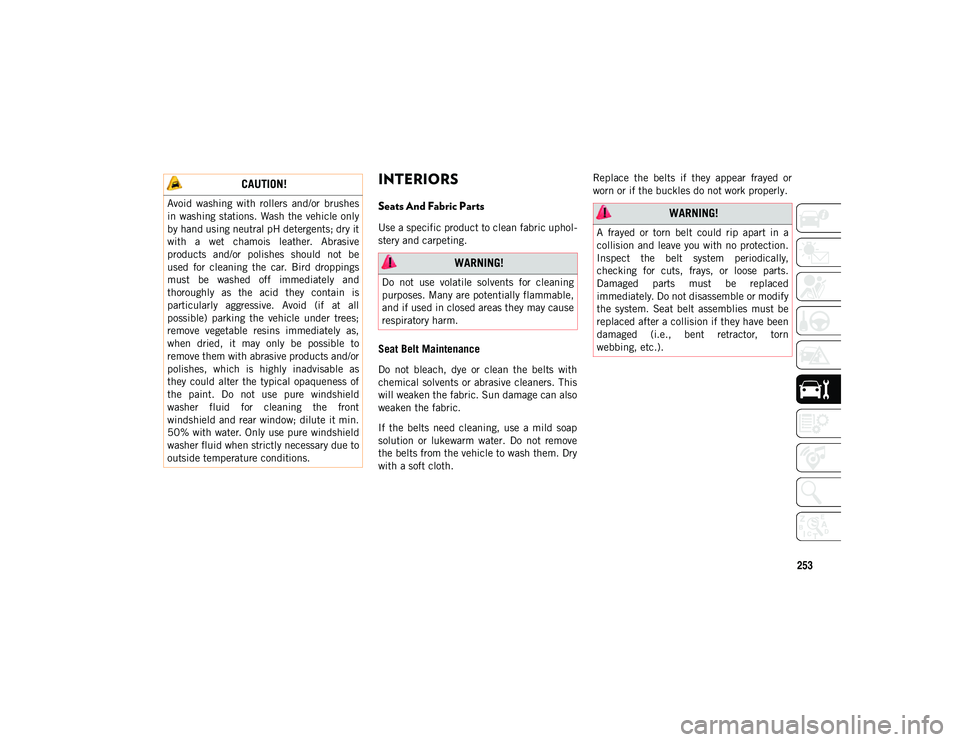
253
INTERIORS
Seats And Fabric Parts
Use a specific product to clean fabric uphol-
stery and carpeting.
Seat Belt Maintenance
Do not bleach, dye or clean the belts with
chemical solvents or abrasive cleaners. This
will weaken the fabric. Sun damage can also
weaken the fabric.
If the belts need cleaning, use a mild soap
solution or lukewarm water. Do not remove
the belts from the vehicle to wash them. Dry
with a soft cloth. Replace the belts if they appear frayed or
worn or if the buckles do not work properly.
CAUTION!
Avoid washing with rollers and/or brushes
in washing stations. Wash the vehicle only
by hand using neutral pH detergents; dry it
with a wet chamois leather. Abrasive
products and/or polishes should not be
used for cleaning the car. Bird droppings
must be washed off immediately and
thoroughly as the acid they contain is
particularly aggressive. Avoid (if at all
possible) parking the vehicle under trees;
remove vegetable resins immediately as,
when dried, it may only be possible to
remove them with abrasive products and/or
polishes, which is highly inadvisable as
they could alter the typical opaqueness of
the paint. Do not use pure windshield
washer fluid for cleaning the front
windshield and rear window; dilute it min.
50% with water. Only use pure windshield
washer fluid when strictly necessary due to
outside temperature conditions.
WARNING!
Do not use volatile solvents for cleaning
purposes. Many are potentially flammable,
and if used in closed areas they may cause
respiratory harm.
WARNING!
A frayed or torn belt could rip apart in a
collision and leave you with no protection.
Inspect the belt system periodically,
checking for cuts, frays, or loose parts.
Damaged parts must be replaced
immediately. Do not disassemble or modify
the system. Seat belt assemblies must be
replaced after a collision if they have been
damaged (i.e., bent retractor, torn
webbing, etc.).
2020_JEEP_CHEROKEE_UG_RHD_UK.book Page 253
Page 256 of 332
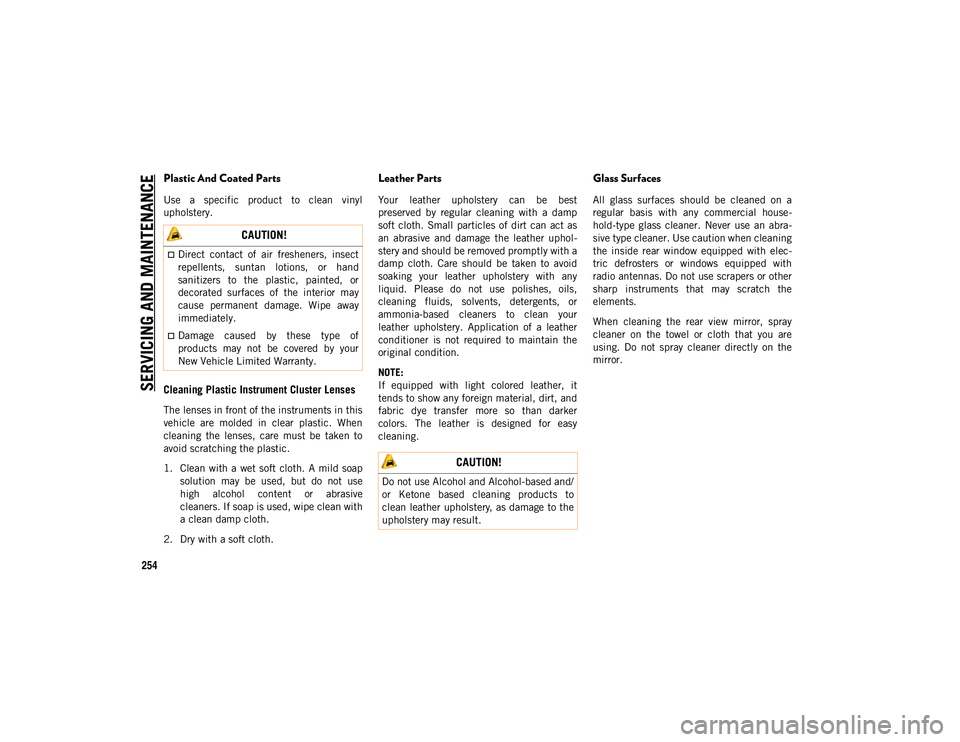
SERVICING AND MAINTENAN
CE
254
Plastic And Coated Parts
Use a specific product to clean vinyl
upholstery.
Cleaning Plastic Instrument Cluster Lenses
The lenses in front of the instruments in this
vehicle are molded in clear plastic. When
cleaning the lenses, care must be taken to
avoid scratching the plastic.
1. Clean with a wet soft cloth. A mild soapsolution may be used, but do not use
high alcohol content or abrasive
cleaners. If soap is used, wipe clean with
a clean damp cloth.
2. Dry with a soft cloth.
Leather Parts
Your leather upholstery can be best
preserved by regular cleaning with a damp
soft cloth. Small particles of dirt can act as
an abrasive and damage the leather uphol -
stery and should be removed promptly with a
damp cloth. Care should be taken to avoid
soaking your leather upholstery with any
liquid. Please do not use polishes, oils,
cleaning fluids, solvents, detergents, or
ammonia-based cleaners to clean your
leather upholstery. Application of a leather
conditioner is not required to maintain the
original condition.
NOTE:
If equipped with light colored leather, it
tends to show any foreign material, dirt, and
fabric dye transfer more so than darker
colors. The leather is designed for easy
cleaning.
Glass Surfaces
All glass surfaces should be cleaned on a
regular basis with any commercial house -
hold-type glass cleaner. Never use an abra -
sive type cleaner. Use caution when cleaning
the inside rear window equipped with elec -
tric defrosters or windows equipped with
radio antennas. Do not use scrapers or other
sharp instruments that may scratch the
elements.
When cleaning the rear view mirror, spray
cleaner on the towel or cloth that you are
using. Do not spray cleaner directly on the
mirror.
CAUTION!
Direct contact of air fresheners, insect
repellents, suntan lotions, or hand
sanitizers to the plastic, painted, or
decorated surfaces of the interior may
cause permanent damage. Wipe away
immediately.
Damage caused by these type of
products may not be covered by your
New Vehicle Limited Warranty.
CAUTION!
Do not use Alcohol and Alcohol-based and/
or Ketone based cleaning products to
clean leather upholstery, as damage to the
upholstery may result.
2020_JEEP_CHEROKEE_UG_RHD_UK.book Page 254
Page 257 of 332
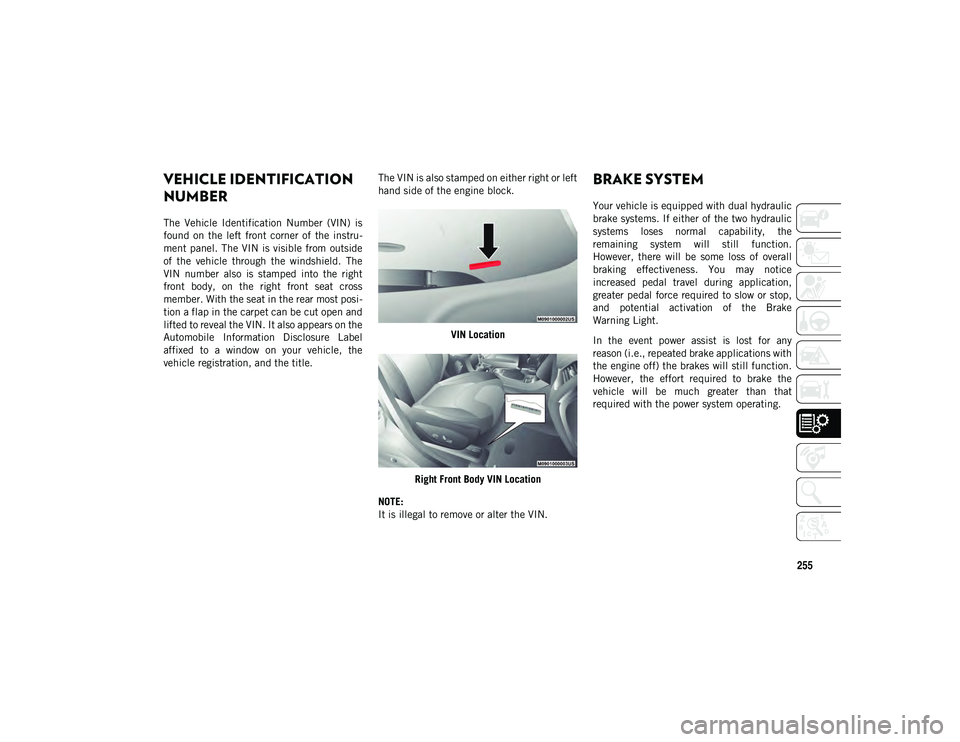
255
TECHNICAL SPECIFICATIONS
VEHICLE IDENTIFICATION
NUMBER
The Vehicle Identification Number (VIN) is
found on the left front corner of the instru-
ment panel. The VIN is visible from outside
of the vehicle through the windshield. The
VIN number also is stamped into the right
front body, on the right front seat cross
member. With the seat in the rear most posi -
tion a flap in the carpet can be cut open and
lifted to reveal the VIN. It also appears on the
Automobile Information Disclosure Label
affixed to a window on your vehicle, the
vehicle registration, and the title. The VIN is also stamped on either right or left
hand side of the engine block.
VIN Location
Right Front Body VIN Location
NOTE:
It is illegal to remove or alter the VIN.
BRAKE SYSTEM
Your vehicle is equipped with dual hydraulic
brake systems. If either of the two hydraulic
systems loses normal capability, the
remaining system will still function.
However, there will be some loss of overall
braking effectiveness. You may notice
increased pedal travel during application,
greater pedal force required to slow or stop,
and potential activation of the Brake
Warning Light.
In the event power assist is lost for any
reason (i.e., repeated brake applications with
the engine off) the brakes will still function.
However, the effort required to brake the
vehicle will be much greater than that
required with the power system operating.
2020_JEEP_CHEROKEE_UG_RHD_UK.book Page 255
Page 258 of 332
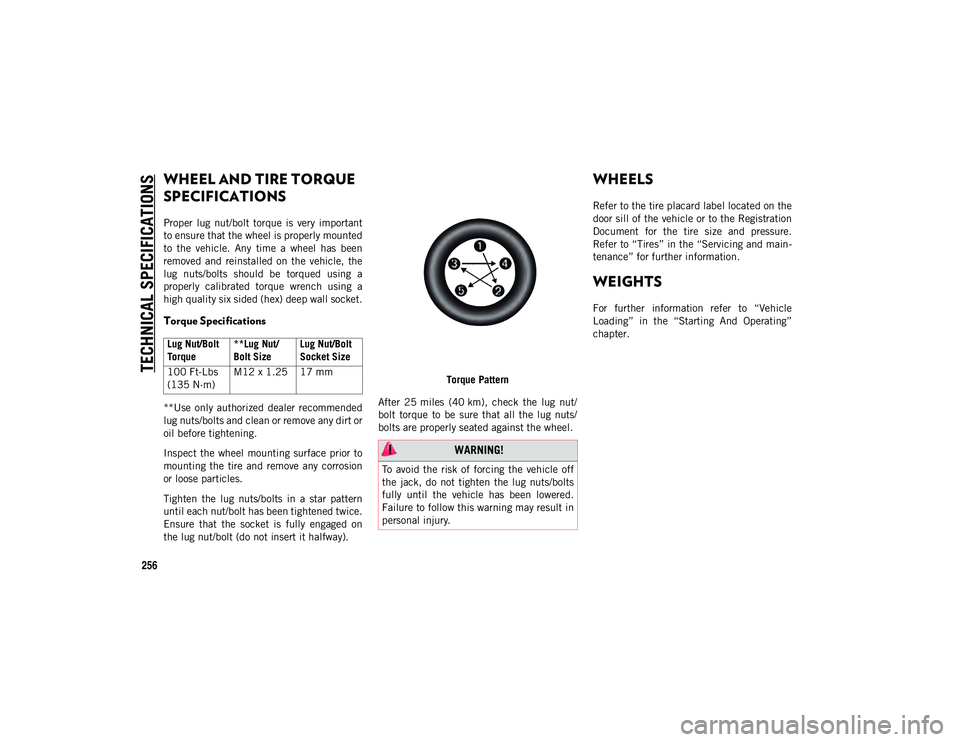
TECHNICAL SPECIFICATIONS
256
WHEEL AND TIRE TORQUE
SPECIFICATIONS
Proper lug nut/bolt torque is very important
to ensure that the wheel is properly mounted
to the vehicle. Any time a wheel has been
removed and reinstalled on the vehicle, the
lug nuts/bolts should be torqued using a
properly calibrated torque wrench using a
high quality six sided (hex) deep wall socket.
Torque Specifications
**Use only authorized dealer recommended
lug nuts/bolts and clean or remove any dirt or
oil before tightening.
Inspect the wheel mounting surface prior to
mounting the tire and remove any corrosion
or loose particles.
Tighten the lug nuts/bolts in a star pattern
until each nut/bolt has been tightened twice.
Ensure that the socket is fully engaged on
the lug nut/bolt (do not insert it halfway).Torque Pattern
After 25 miles (40 km), check the lug nut/
bolt torque to be sure that all the lug nuts/
bolts are properly seated against the wheel.
WHEELS
Refer to the tire placard label located on the
door sill of the vehicle or to the Registration
Document for the tire size and pressure.
Refer to “Tires” in the “Servicing and main -
tenance” for further information.
WEIGHTS
For further information refer to “Vehicle
Loading” in the “Starting And Operating”
chapter.
Lug Nut/Bolt
Torque **Lug Nut/
Bolt SizeLug Nut/Bolt
Socket Size
100 Ft-Lbs
(135 N·m) M12 x 1.25 17 mm
WARNING!
To avoid the risk of forcing the vehicle off
the jack, do not tighten the lug nuts/bolts
fully until the vehicle has been lowered.
Failure to follow this warning may result in
personal injury.
2020_JEEP_CHEROKEE_UG_RHD_UK.book Page 256
Page 259 of 332
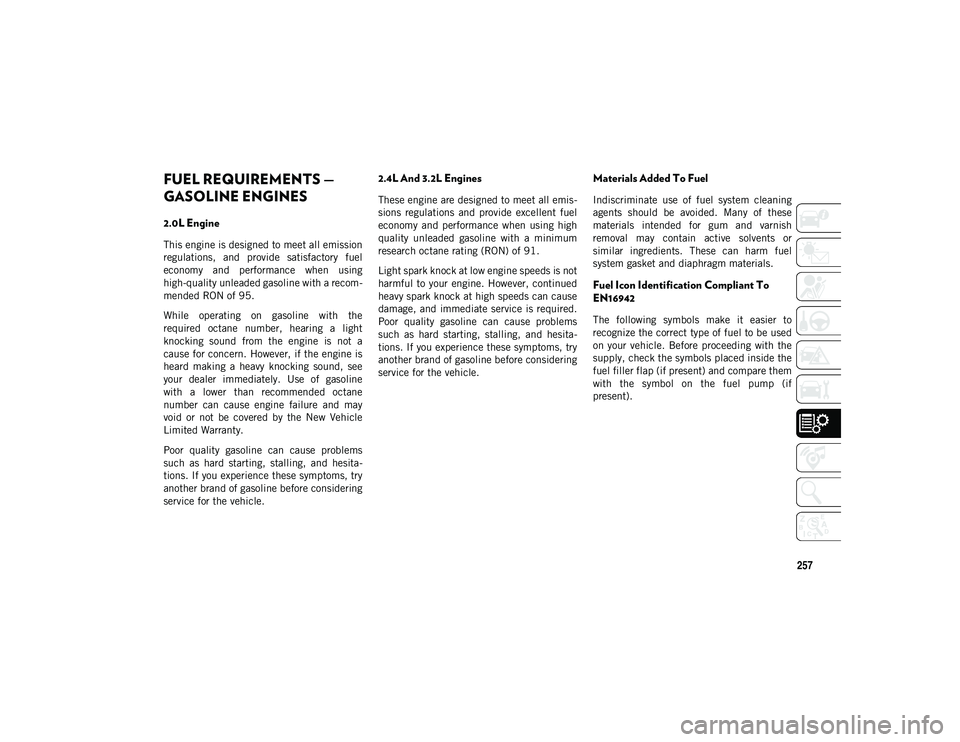
257
FUEL REQUIREMENTS —
GASOLINE ENGINES
2.0L Engine
This engine is designed to meet all emission
regulations, and provide satisfactory fuel
economy and performance when using
high-quality unleaded gasoline with a recom-
mended RON of 95.
While operating on gasoline with the
required octane number, hearing a light
knocking sound from the engine is not a
cause for concern. However, if the engine is
heard making a heavy knocking sound, see
your dealer immediately. Use of gasoline
with a lower than recommended octane
number can cause engine failure and may
void or not be covered by the New Vehicle
Limited Warranty.
Poor quality gasoline can cause problems
such as hard starting, stalling, and hesita -
tions. If you experience these symptoms, try
another brand of gasoline before considering
service for the vehicle.
2.4L And 3.2L Engines
These engine are designed to meet all emis -
sions regulations and provide excellent fuel
economy and performance when using high
quality unleaded gasoline with a minimum
research octane rating (RON) of 91.
Light spark knock at low engine speeds is not
harmful to your engine. However, continued
heavy spark knock at high speeds can cause
damage, and immediate service is required.
Poor quality gasoline can cause problems
such as hard starting, stalling, and hesita -
tions. If you experience these symptoms, try
another brand of gasoline before considering
service for the vehicle.
Materials Added To Fuel
Indiscriminate use of fuel system cleaning
agents should be avoided. Many of these
materials intended for gum and varnish
removal may contain active solvents or
similar ingredients. These can harm fuel
system gasket and diaphragm materials.
Fuel Icon Identification Compliant To
EN16942
The following symbols make it easier to
recognize the correct type of fuel to be used
on your vehicle. Before proceeding with the
supply, check the symbols placed inside the
fuel filler flap (if present) and compare them
with the symbol on the fuel pump (if
present).
2020_JEEP_CHEROKEE_UG_RHD_UK.book Page 257
Page 260 of 332
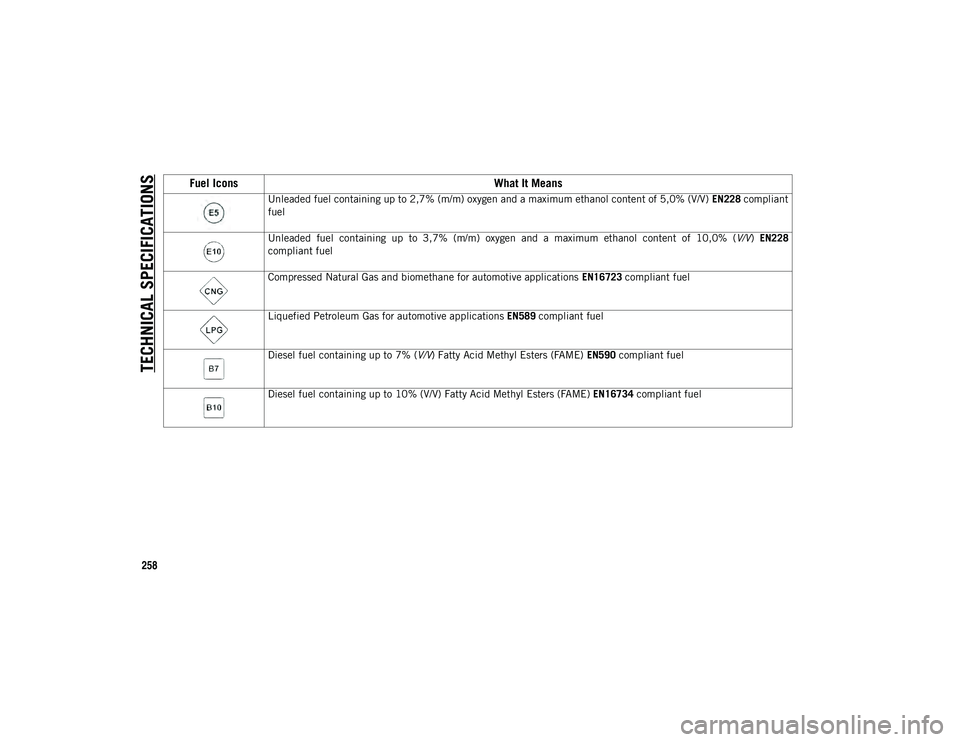
TECHNICAL SPECIFICATIONS
258Fuel Icons
What It Means
Unleaded fuel containing up to 2,7% (m/m) oxygen and a maximum ethanol content of 5,0% (V/V) EN228 compliant
fuel
Unleaded fuel containing up to 3,7% (m/m) oxygen and a maximum ethanol content of 10,0% ( V/V) EN228
compliant fuel
Compressed Natural Gas and biomethane for automotive applications EN16723 compliant fuel
Liquefied Petroleum Gas for automotive applications EN589 compliant fuel
Diesel fuel containing up to 7% ( V/V) Fatty Acid Methyl Esters (FAME) EN590 compliant fuel
Diesel fuel containing up to 10% (V/V) Fatty Acid Methyl Esters (FAME) EN16734 compliant fuel
2020_JEEP_CHEROKEE_UG_RHD_UK.book Page 258